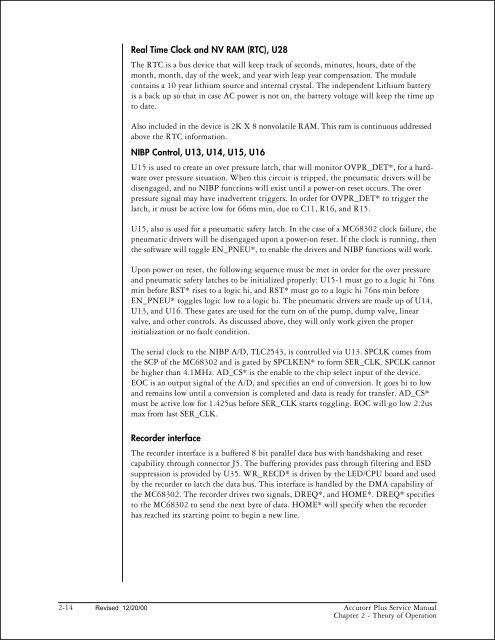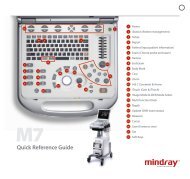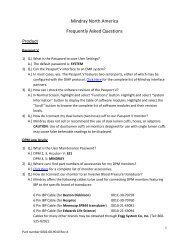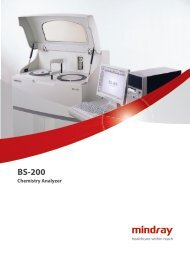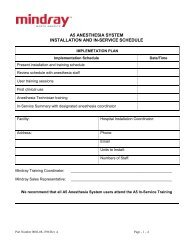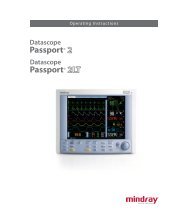Accutorr Plus Service Manual - Mindray
Accutorr Plus Service Manual - Mindray
Accutorr Plus Service Manual - Mindray
Create successful ePaper yourself
Turn your PDF publications into a flip-book with our unique Google optimized e-Paper software.
Real Time Clock and NV RAM (RTC), U28<br />
The RTC is a bus device that will keep track of seconds, minutes, hours, date of the<br />
month, month, day of the week, and year with leap year compensation. The module<br />
contains a 10 year lithium source and internal crystal. The independent Lithium battery<br />
is a back up so that in case AC power is not on, the battery voltage will keep the time up<br />
to date.<br />
Also included in the device is 2K X 8 nonvolatile RAM. This ram is continuous addressed<br />
above the RTC information.<br />
NIBP Control, U13, U14, U15, U16<br />
U15 is used to create an over pressure latch, that will monitor OVPR_DET*, for a hardware<br />
over pressure situation. When this circuit is tripped, the pneumatic drivers will be<br />
disengaged, and no NIBP functions will exist until a power-on reset occurs. The over<br />
pressure signal may have inadvertent triggers. In order for OVPR_DET* to trigger the<br />
latch, it must be active low for 66ms min, due to C11, R16, and R15.<br />
U15, also is used for a pneumatic safety latch. In the case of a MC68302 clock failure, the<br />
pneumatic drivers will be disengaged upon a power-on reset. If the clock is running, then<br />
the software will toggle EN_PNEU*, to enable the drivers and NIBP functions will work.<br />
Upon power on reset, the following sequence must be met in order for the over pressure<br />
and pneumatic safety latches to be initialized properly: U15-1 must go to a logic hi 76ns<br />
min before RST* rises to a logic hi, and RST* must go to a logic hi 76ns min before<br />
EN_PNEU* toggles logic low to a logic hi. The pneumatic drivers are made up of U14,<br />
U13, and U16. These gates are used for the turn on of the pump, dump valve, linear<br />
valve, and other controls. As discussed above, they will only work given the proper<br />
initialization or no fault condition.<br />
The serial clock to the NIBP A/D, TLC2543, is controlled via U13. SPCLK comes from<br />
the SCP of the MC68302 and is gated by SPCLKEN* to form SER_CLK. SPCLK cannot<br />
be higher than 4.1MHz. AD_CS* is the enable to the chip select input of the device.<br />
EOC is an output signal of the A/D, and specifies an end of conversion. It goes hi to low<br />
and remains low until a conversion is completed and data is ready for transfer. AD_CS*<br />
must be active low for 1.425us before SER_CLK starts toggling. EOC will go low 2.2us<br />
max from last SER_CLK.<br />
Recorder interface<br />
The recorder interface is a buffered 8 bit parallel data bus with handshaking and reset<br />
capability through connector J5. The buffering provides pass through filtering and ESD<br />
suppression is provided by U35. WR_RECD* is driven by the LED/CPU board and used<br />
by the recorder to latch the data bus. This interface is handled by the DMA capability of<br />
the MC68302. The recorder drives two signals, DREQ*, and HOME*. DREQ* specifies<br />
to the MC68302 to send the next byte of data. HOME* will specify when the recorder<br />
has reached its starting point to begin a new line.<br />
2-14 Revised 12/20/00<br />
<strong>Accutorr</strong> <strong>Plus</strong> <strong>Service</strong> <strong>Manual</strong><br />
Chapter 2 - Theory of Operation


